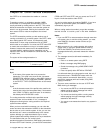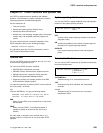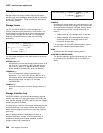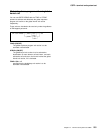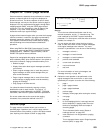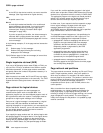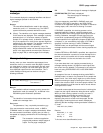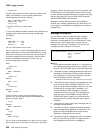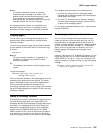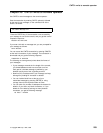
CSPG—page retrieval
Display information about logical
messages
This command displays the message identifiers and titles of
logical messages queued for this terminal.
getpageQ
Getpage
The user-defined identification code for the retrieval
transaction, and is 1–7 characters long. The PGRET
system initialization parameter defines this code.
Q (Query). The identifiers of all logical messages destined
for this terminal are displayed. If the message is security
protected (that is, if it has been routed to a specific
operator ID or operator class), its identifier is displayed
only if the operator ID or class for the operator signed on
matches that in the message. The identifier consists of a
6-digit hexadecimal number, a 2-character
temporary-storage prefix, and optionally, a title. The
6-digit hexadecimal number can be used as the hhhhhh
option in the page retrieval command (see “Retrieve a
page” on page 253) to retrieve pages for this display.
Message chaining
Usually, when you have viewed the output pages from a
transaction, there is no need to retain the pages. However,
you might want to initiate a new transaction and still retain
the old pages, so that you can view them again after you
have displayed output from the new transaction. This is
called
message chaining
and can be done using the
following command:
─ ──CSPG ──Messchnyyyy ──┬ ┬──────────── ─
└┘─Parameters─
Messchn
The installation-defined message-chaining transaction
identification code (for example, C/), as defined in the
PGCHAIN system initialization parameter.
Yyyy
The identifier of a transaction that produces data to be
added to the message chain.
Parameters
The parameters, if any, required by transaction yyyy.
If the new transaction uses terminal control, or BMS in
TERMINAL mode, its output is displayed immediately. When
the new transaction terminates, anything else you enter is
interpreted as a paging command for the first message. For
example:
TRAN The transaction invokes an application
program that produces multiple pages of
output. The first page is displayed.
P/2 The second page of message is displayed.
C/CEMT INQ TIM CEMT data is displayed.
P/2 The second page of message is
redisplayed.
If the new transaction uses BMS in PAGING mode, and
RETAIN or RELEASE is specified in the SEND PAGE
command in the application program, the output is chained to
existing output, and a new level of chaining is created.
If RELEASE is specified, this chaining process can be
repeated indefinitely. However, chaining requests must
always be made while viewing pages at the highest level of
chaining. Otherwise, messages at levels higher than the
current level is automatically purged (if OPERPURGE has
not been specified in the application program SEND PAGE
command), or you are asked to purge them. If RETAIN is
specified, no further chaining (in either TERMINAL or
PAGING mode) can be performed until the second logical
message has been terminated. Further chaining requests are
rejected.
If neither RETAIN nor RELEASE is specified, the output from
the second transaction is queued as a new message for the
terminal, and is not received until all earlier messages have
been terminated. It is thus not chained to the current
message.
If you enter data that is not a paging command during a
message chaining session, all pages on levels higher than
the current level are deleted, if no message in the chain has
been built using OPERPURGE=YES in the SEND PAGE
command.
An example of the use of message chaining under BMS in
PAGING mode is a search of a personnel file for people who
speak French. Your initial inquiry might turn up three names.
Without terminating the page containing the names, you can
examine the records of each of the three people named. The
chaining transaction could be used to read a record, without
erasing the three names.
This would create output at the second level of chaining (the
output from the original transaction being first-level output).
When you finish viewing a person’s record, you enter a
paging command to terminate the current level, see
“Message termination” on page 256. The message
displaying the person’s record would be purged, and the
original page, containing the three names, redisplayed.
Assuming that the message chaining transaction identifier is
C/, enter:
LANG DEPT=J34,FRENCH
Receive:
BERESFORD, J.A. 143
LEVY, A.R. 7121
WALTON, J. 8143
To find out more about Beresford, enter:
Chapter 22. Page retrieval CSPG 255



